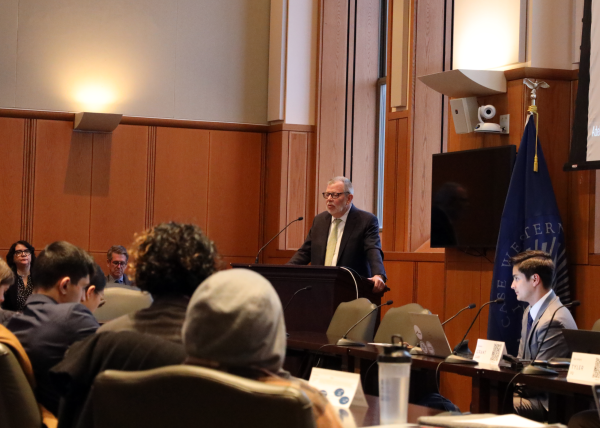Bioengineering professor gives talk on biology, physics working together
March 24, 2017
Some people usually don’t see biology and physics as having many inherent similarities. Herbert Levine, physicist and professor of bioengineering at Rice University, seeks to challenge that view.
In a talk on March 8 at the Euclid Tavern, Levine described in detail the ways in which computational modeling can be used to develop a detailed understanding and appreciation of the mechanics underlying cell movement. In his estimation, his work in this area is a key example of how physics can profoundly inform and enhance our knowledge of biology.
The talk was called “Cells that Figure out Where to Go: Smart Behavior from Amoebae to our Immune System,” and dealt with the methods employed by cells of varying degrees of complexity to ensure accurate navigation. According to Levine, organisms such as amoebae and white blood cells can be broadly grouped together when it comes to motion. This is because they both rely on the same general mechanisms in order to move to target locations within their respective environments.
“Cells figure out where to go by using primitive ‘senses,’ mostly smell—detecting chemicals—and touch—detecting the hardness of surfaces,” said Levine. “[Of course] for cells, chemical detection is usually more important than any mechanical stimulus.”
According to him, such methods of detection are crucial for cells to establish which parts of their surroundings are “favorable” to move towards, and to distinguish such desirable areas from more “unfavorable” locations. He provided an example: In much the same way that human beings are attracted to fragrant scents and repulsed by putrid stenches, cells “know” to move to certain places because such locations emit chemical signals that are “attractive” to them.
“Cells are incredibly sophisticated in terms of their overall capabilities as compared to almost anything synthetic,” said Levine. “[They] can forage for food, can move to ‘higher ground’ when faced with stressors [and can even] delay division when faced with other needs for resources.”
Levine went on to explain that in contrast to the popular view of such self-preserving activities as being purely the domain of so-called “higher” organisms, many of these complex behaviors developed much earlier in the evolution of life than most people realize. Moreover, a significant number of the abilities displayed by microorganisms easily outstrip not only those of higher-order species, but even those of the most advanced machines.
“With all the progress on self-driving cars and the like, we still cannot build robots that refuel themselves ‘off the land,’ reproduce, respond to a wide range of different stimuli and survive in a wide range of environments,” Levine declared.
It was the realization of how much more complicated cells can be than even technology that led Levine to focus much of his work on computerized models of cellular movement. This approach to studying cell motility is unorthodox, to say the least, due in no small part to the amount of guesswork and speculation involved.
Because of the tiny scale of their subjects and the very subtle nature of their activities, Levine and his team must work by first developing plausible-sounding models of cell motion, and then testing their accuracy in “real life.” It is meticulous but often precarious work.
“We usually [begin by formulating] a series of computer models, starting from a simple one and proceeding to more realistic ones, that challenge us to see if we really understand how it might work,” said Levine.
Once he and his colleagues have determined that a model accurately captures the specific cellular phenomena under observation, they can extrapolate it to predict hypothetical alternative scenarios, such as the potential response of cells to chemical signals that are received in staggered bursts rather than in one continuous wave.
“This strategy of build something simple, test it and then try to have it fail by devising increasingly sophisticated tests is not a typical approach for someone without a physical science background,” he admitted. “[However], in our opinion it does lead to a more complete and quantitative understanding of how something like directed cell movement actually works [than a traditional biological approach might allow].”
Levine believes that his research exemplifies an often underappreciated link between physics and biology. In his opinion, other than the obvious technological contributions made by physics to the life sciences (such as microscopes and magnetic resonance imaging (MRI) technology), the full potential for cooperation between the two fields is not often grasped by the public. This is something he aspires to change.
“I hope to show with my work that physics can also contribute new conceptual ways of thinking about the possible ways in which complex [biological] systems can carry out complex functions,” said Levine.
He stresses that neither field can work in a vacuum, and that each would only be enriched by fully utilizing the other.
















